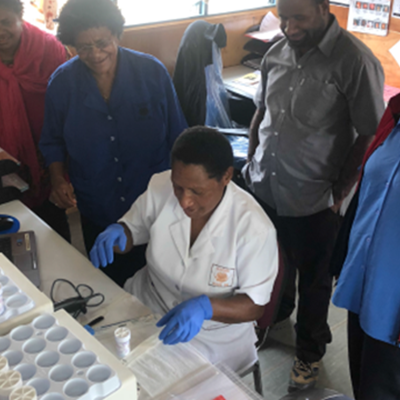
 Cervical Cancer Screening in Papua New Guinea
Cervical Cancer Screening in Papua New Guinea
Papua New Guinea (PNG) has among the highest estimated burdens of cervical cancer globally (estimated age-standardised incidence rate 29.1 per 100,000; age-standardised mortality rate 19.8/100,000) but currently has no national cervical screening program.1,2 Since 2012, the Papua New Guinea Institute of Medical Research has undertaken a number of studies aimed at identifying a locally appropriate model for cervical screening and early treatment.
Visual inspection with acetic acid (VIA) was has been investigated as a potential screening strategy in PNG, however, VIA positivity was found to be only associated with HPV16 infection and not with other high-risk HPV types that are also associated with cervical pre-cancer and cancer.2 A recent evaluation of point-of-care HPV-DNA testing (using the Xpert® HPV Test) on self-collected vaginal specimens within clinical settings in PNG has shown great promise in identifying women at risk of high-grade cervical disease.3, 4
In this study, point-of-care Xpert HPV testing using self-collected specimens outperformed VIA, or a combination of HPV testing plus VIA, for the detection of underlying high-grade squamous intraepithelial lesions.4, 5 A field trial among 3400 women in PNG to confirm these initial findings is now underway that will also evaluate the cost-effectiveness, health system implementation requirements and acceptability of this ‘test and treat’ strategy.
References:
[1] WHO/IARC. GLOBOCAN 2018: Estimated Cancer Incidence, Mortality and Prevalence Worldwide in 2018. [Access date: 13 February 2019.] Available from URL: http://gco.iarc.fr/today/data/factsheets/populations/598-papua-new-guinea-fact-sheets.pdf
[2] Vallely AJ, Toliman PJ, Ryan C, Rai G, Wapling J, Gabuzzi J, et al. Association between visual inspection of the cervix with acetic acid examination and high-risk human papillomavirus infection, Chlamydia trachomatis, Neisseria gonorrhoeae and Trichomonas vaginalis in Papua New Guinea. The Australian & New Zealand Journal of Obstetrics and Gynaecology. 2018; 58(5): 576-81.
[3] Toliman P, Badman SG, Gabuzzi J, Silim S, Forereme L, Kumbia A, et al. Field Evaluation of Xpert HPV Point-of-Care Test for Detection of Human Papillomavirus Infection by Use of Self-Collected Vaginal and Clinician-Collected Cervical Specimens. J Clin Microbiol. 2016;54(7):1734-7
[4] Toliman PJ, Kaldor JM, Badman SG, Gabuzzi J, Silim S, Kumbia A, et al. Performance of clinical screening algorithms comprising point-of-care HPV-DNA testing using self-collected vaginal specimens, and visual inspection of the cervix with acetic acid, for the detection of underlying high-grade squamous intraepithelial lesions in Papua New Guinea. Papillomavirus Research (Amsterdam, Netherlands). 2018.
[5] Toliman PJ, Kaldor JM, Badman SG, Phillips S, Tan G, Brotherton JML, et al. Evaluation of self-collected vaginal specimens for the detection of high-risk human papillomavirus infection and the prediction of high-grade cervical intraepithelial lesions in a high-burden, low-resource setting. Clinical Microbiology and Infection: The official publication of the European Society of Clinical Microbiology and Infectious Diseases. 2018.